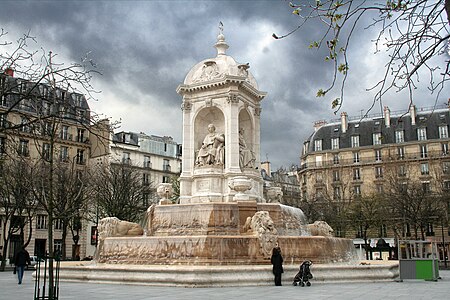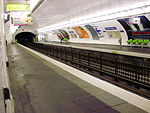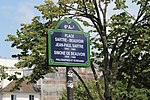Fontaine Saint-Sulpice

The Fontaine Saint-Sulpice (also known as the Fontaine de la place Saint-Sulpice or as the Fontaine des Orateurs-Sacré) is a monumental fountain located in Place Saint-Sulpice in the 6th arrondissement of Paris. It was constructed between 1843 and 1848 by the architect Louis Visconti, who also designed the tomb of Napoleon. The four figures on the fountain represent four French religious figures of the 17th century famous for their eloquence. Bossuet, North, statue by Jean-Jacques Feuchère Fénelon, East, statue by François Lanno Fléchier, West, statue by Louis Desprez Massillon, South, statue by Jacques-Auguste Fauginet, completed by Fouquiet after the death of Fauginet.In French the fountain is also called "La Fontaine des quatre points cardinaux", a pun which means the "Fountain of the four points of the compass" or "Fountain of the four not cardinals". This name is also a pun, because "points cardinaux" in French is a play on words. The four bishops portrayed in the statues, while renowned, were never elevated to the rank of cardinal.
Excerpt from the Wikipedia article Fontaine Saint-Sulpice (License: CC BY-SA 3.0, Authors, Images).Fontaine Saint-Sulpice
Place Saint-Sulpice, Paris Quartier de l'Odéon (Paris)
Geographical coordinates (GPS) Address External links Nearby Places Show on map
Geographical coordinates (GPS)
| Latitude | Longitude |
|---|---|
| N 48.850833333333 ° | E 2.3333333333333 ° |
Address
Fontaine des quatre évêques
Place Saint-Sulpice
75006 Paris, Quartier de l'Odéon (Paris)
Ile-de-France, France
Open on Google Maps











